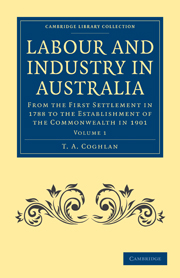 Labour and Industry in Australia
Labour and Industry in Australia Book contents
- Frontmatter
- PREFACE
- Contents
- PART I FROM THE FOUNDATION OF SETTLEMENT TO THE CROSSING OF THE MOUNTAINS
- PART II FROM THE CROSSING OF THE MOUNTAINS TO THE ABOLITION OF THE ASSIGNMENT SYSTEM
- PART III FROM THE ABOLITION OF THE ASSIGNMENT SYSTEM TO THE DISCOVERY OF GOLD
- I INTRODUCTION TO THE THIRD PERIOD
- II TRANSPORTATION
- III IMMIGRATION
- IV LAND LEGISLATION IN NEW SOUTH WALES, VAN DIEMEN'S LAND, AND WESTERN AUSTRALIA
- V LAND LEGISLATION AND SETTLEMENT IN SOUTH AUSTRALIA AND THE WAKEFIELD THEORY OF COLONIZATION
- VI LABOUR AND WAGES
- VII PRICES
- VIII FINANCIAL CRISIS OF 1841, 1842, AND 1843
- IX INDUSTRIES
- PART IV FROM THE DISCOVERY OF GOLD TO THE INTRODUCTION OF FREE SELECTION OF LAND BEFORE SURVEY
I - INTRODUCTION TO THE THIRD PERIOD
Published online by Cambridge University Press: 05 August 2011
- Frontmatter
- PREFACE
- Contents
- PART I FROM THE FOUNDATION OF SETTLEMENT TO THE CROSSING OF THE MOUNTAINS
- PART II FROM THE CROSSING OF THE MOUNTAINS TO THE ABOLITION OF THE ASSIGNMENT SYSTEM
- PART III FROM THE ABOLITION OF THE ASSIGNMENT SYSTEM TO THE DISCOVERY OF GOLD
- I INTRODUCTION TO THE THIRD PERIOD
- II TRANSPORTATION
- III IMMIGRATION
- IV LAND LEGISLATION IN NEW SOUTH WALES, VAN DIEMEN'S LAND, AND WESTERN AUSTRALIA
- V LAND LEGISLATION AND SETTLEMENT IN SOUTH AUSTRALIA AND THE WAKEFIELD THEORY OF COLONIZATION
- VI LABOUR AND WAGES
- VII PRICES
- VIII FINANCIAL CRISIS OF 1841, 1842, AND 1843
- IX INDUSTRIES
- PART IV FROM THE DISCOVERY OF GOLD TO THE INTRODUCTION OF FREE SELECTION OF LAND BEFORE SURVEY
Summary
Sir Richard Bourke was followed in the governorship of New South Wales by Sir George Gipps, who found the conditions of colonization very different from those prevailing at the beginning of the second period. The main settlements of New South Wales and Van Diemen's Land were still convict colonies, but the assignment of convict labour had been abolished in New South Wales, and transportation was about to cease; independent colonies had been established on the shores of the Gulf of St. Vincent and on the Swan River; there were subsidiary settlements at Port Phillip and in New Zealand; and the convicts were being withdrawn from Brisbane to make the way clear for free settlers.
This third period in the history of Australia extends to the year 1851, when the great gold discoveries were made, which, in Wentworth's expressive phrase, precipitated Australia into a nation. It was a period of very great changes, especially in New South Wales, which at the beginning passed through two years of raging and tearing speculation leading up to a disastrous financial crisis, which reached its acutest phase in 1842. During the rest of the period the colony remained in a very depressed condition. The depression affected Van Diemen's Land and South Australia as well, but its evil effects were most persistent in Sydney. In spite, however, of its bad economic condition, New South Wales made great progress towards political freedom.
- Type
- Chapter
- Information
- Labour and Industry in AustraliaFrom the First Settlement in 1788 to the Establishment of the Commonwealth in 1901, pp. 293 - 320Publisher: Cambridge University PressPrint publication year: 2011First published in: 1918


